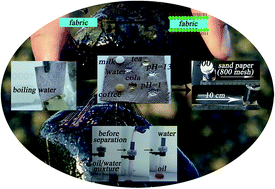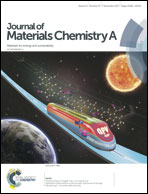Simple one-pot approach toward robust and boiling-water resistant superhydrophobic cotton fabric and the application in oil/water separation†
Abstract
Inspired by the strong adhesion of mussel, taking advantage of a simple one-pot approach, we designed a robust and boiling-water resistant superhydrophobic polydopamine@SiO2(PDA@SiO2) coated cotton fabric through copolymerization reaction and trimethyl silyl modified process at room temperature. The as-prepared fabric not only shows great resistance to mechanical abrasion, wear and ultrasonic treatment but also has excellent superhydrophobicity stability towards UV irradiation, high temperature and organic solvents immersion. More importantly, the superhydrophobic fabric also exhibits boiling water (99 °C) repelling properties, while several superhydrophobic surfaces lose their superhydrophobicity when exposed to hot water with temperature more than 50 °C. It is also noticeable that the purity of all the collected oil is as high as 99.9% when superhydrophobic fabric is used to separate oil/water mixture for 20 cycles, indicating the high oil/water separation efficiency of the fabric. We believe that the modified fabric is environmentally friendly, low cost and easy to fabricate, and thus exhibits great potential applications in solving the serious problems of oily waste water and scald-protection clothes.



 Please wait while we load your content...
Please wait while we load your content...